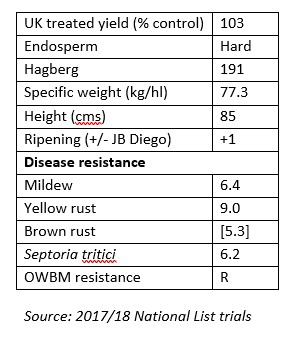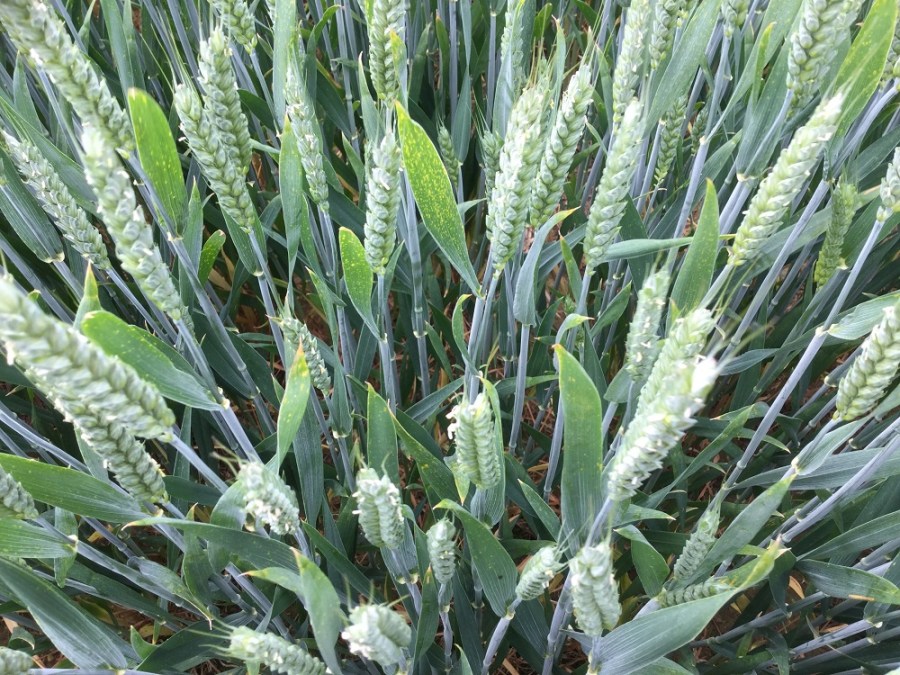Hard Group 4 feed varieties have long been the go-to choice for growers looking for out-and-out yield, but now some also bring in good agronomics and grain quality. CPM reviews six market contenders.
Used wisely, the options available can help spread risk as well as maximise returns.
By Tom Allen-Stevens
You can say all you like about value-added markets, flexible wheats and opportunities for the UK farmer once Britain has exited the EU. The fact remains, a British grower’s favourite wheat remains a Group 4 hard feed variety, and has done for over a decade.
And it’s for two simple reasons, according to Hutchinsons’ seed manager David Bouch. “The feed market remains the UK’s biggest market for home-grown wheat, and these varieties fill the barn without complications in terms of intake requirements.”
The standard specification is 15% moisture and 72kg/hl specific weight – even in a tough year, it’s a spec any UK grower should be able to meet, and there’ll be no shortage of homes for it, he says. “There are even one or two opportunities to pick up a premium contract with a Group 4 hard feed variety.”
That’s not to say variety choice isn’t important, however. “Used wisely, the options available can help spread risk as well as maximise returns. The beauty of dealing with one heap of end product is that it doesn’t matter how many varieties you grow, so it’s worth shopping around and finding a portfolio of wheats that suit your needs.”
To help things along, he’s picked out six choices he feels will form the backbone of the Group 4 market this autumn.
Gleam
New to the AHDB Recommended List last year, this variety is a step on from its stable mate Graham, reckons David. “There’s a higher yield and it also has orange wheat blossom midge (OWBM) resistance, that shouldn’t be underestimated.”
Gleam offers flexibility in terms of sowing date. “It’s suitable for early sowing, but it’s fine drilled at a later date, while figures suggest it’s reasonable in the second wheat slot.”
The rest of its scores, while none of them are stand-out, suggest a good solid on-farm performer with no weaknesses, says David. “The one thing the RL figures do show is consistency – it performs well across the country, across years and soil types.” Having sold out and taken 4.5% of the certified wheat market for 2019 harvest, he’s expecting market share to increase to around 8.5%.
Consistency is what Sam Brooke from breeder Syngenta notes about Gleam. “It also has one of the highest septoria scores of the hard feeds. It has a slow growth habit to GS31, making it suitable to drill early, but we’ve found it does just as well when sown in Nov.”
Graham
With 8-9% of the wheat market, Graham has very quickly become a farmer favourite, says David. “Good agronomics give it a high untreated yield. You can drill it early and it has stiff straw.”
The variety has the highest septoria score of the hard Group 4s. “That means it’s a stand-out variety in the West, but there’s a good yellow rust score, making it equally suitable for growers in the East, while there’s less appeal for growers in the North.”
It’s best positioned in the early drilling slot, although can be sown later. “It has a high specific weight and its high Hagberg suggests it’ll resist sprouting – it’s little wonder this variety has become a firm favourite,” adds David.
Sam puts some of Graham’s strengths down to its French background. “It’s brought in new genetics. Graham’s a massive tillerer, best in the early slot but reasonably flexible. It was a potential bread-maker, which explains the grain quality.”
RGT Gravity
“3G is the way to go,” says David, and this is the third ‘G’ in his line-up, although also the variety that tops the hard Group 4s on yield. “Gravity has KWS Santiago in its parentage, which is a barometer of yield, and figures back this up – it’s had one poor year, but otherwise has put in some of the highest yields we’ve seen in National List and RL trials.”
Agronomics aren’t quite as strong, he notes, although it has the advantage of OWBM resistance. “There’s a relatively weak septoria score, so growers in the West should take care, but it’s certainly got everything a grower in the East will look for and is equally one of the strongest performers in the North.”
Having seen it come top in both years of NL trials, RAGT fast-tracked Gravity to the market for 2018 harvest, when it took a 2% share of the market, says the firm’s Cathy Hooper. Current market share is around 7%.
“It’s not suitable for early drilling, better suited for Oct, and ideal after roots. RGT Gravity tillers well with a big biomass and it also looks good in the field,” she says.
KWS Kerrin
Here’s another Santiago cross that’s put in a very strong performance yield-wise and also has the benefit of OWBM resistance. “It’s only recommended for the East and West, although strangely has the highest yield figures for the North,” notes David.
This recommendation is probably due to its low Hagberg, he adds. “In every other respect it looks just as good as Gravity.” This includes a similarly low septoria score, although other disease ratings are notably higher. “There’s a good brown rust score, although yellow rust is on the relatively low side.”
Kerrin has 7.1% of the certified market, and its expected share next year will depend somewhat on KWS Kinetic.
Growers who like an out-and-out yielder warm to KWS Kerrin, says the breeder’s Will Compson. “It’s one of the closest to Santiago in terms of consistency across years and across sites. One of the best performers you’ll find as a first wheat, it’s also very strong in the second wheat slot.”
Dunston
This is one of four wheats from Elsoms, newly recommended two years ago, that’s retained its favour, and with good reason, says David. “It performs well and has good agronomics.”
Its septoria and eyespot scores are particularly notable – among the highest combination, bringing Dunston an impressive untreated yield. “It’s easier to manage, although still responds to chemistry. It’s also consistent across regions and performs as a second wheat. And it’s a bit taller, although has the stem stiffness, so may suit growers with a use for its straw.”
Seed availability should be good says breeder Elsoms, with a 2% share expected. “It’s an excellent all rounder, with good straw strength and high grain quality,” says Elsoms’ George Goodwin. “It suits growers where septoria pressure is high and has flexibility on drilling dates.”
Costello
In 2012, when specific weights dropped below 70kg/hl and even feed wheat was hard to shift, that’s when JB Diego made its mark and Costello, from the same breeder, looks to have similar attributes. “It has the highest value on the RL with a Hagberg over 300. This is the one you can rely on in a tricky year,” notes David.
Yield-wise, it’s unlikely to appeal, but growers shouldn’t get hung up on figures, he argues. “Four points below the leaders is barely significant, but agronomically it’s very sound with stiff straw and no weaknesses. It’s a move on from JB Diego.”
It was the grain quality that kept JB Diego at the top of the market for so many years, says Jeremy Taylor from breeder Senova. “Reliability is what growers like about Costello. It’s a good universal variety, although not one for early drilling. It has about 5.5% market share and we’d look for it to increase to over 6% this autumn.”
Group 4s line up on Candidate List
With one exception, all the AHDB Candidate varieties are feed types, notes David. “That suggests there’ll be a big influx next year. But with LG Skyscraper looking as though it tops the lot on yield, they’ll have to shine if they’re to get full recommendation.”
One variety he’s tipped to make it, however, is KWS Kinetic. “It’s a Kerrin plus – it has all of the variety’s attributes but fills in its weaknesses. What’s notable is its grain quality – there’s a very high Hagberg, and a higher septoria score is also sure to attract attention.”
The 1% of the market share expected to be available this autumn will probably sell out, he reckons. “Growers will try it alongside Kerrin, and I expect they’ll then move over to Kinetic.”
Six Group 4 wheat options at a glance

New contender may present a smart fit on farm
A new hard feed wheat that combines top yields with good early vigour and good resistance against key diseases is being launched by Agrovista for this coming autumn.
Sartorial is a cross of KWS Santiago from the same breeder, explains Agrovista technical seed specialist Stuart Cree. “We liked the look of Sartorial early on. It’s in the same yield bracket as KWS Kerrin, Gleam and RGT Gravity, yielding 105% of controls in breeder trials.”
Early development is one of its strengths, he says. “Sartorial is very quick to get away and exhibits rapid early growth. It established remarkably well in our establishment trials last autumn across the four key sites from Suffolk to the Scottish Borders.”
The variety averaged almost 78% establishment across a range of medium and heavy soils, significantly better than the other three heavyweights that averaged around 60%. “You could pick it out early on,” says Stuart.
Sartorial is ideally suited to Oct drilling, but can be sown from mid-Sept to the end of Jan with due regard to seed rates and spring management, he advises.
“Its early vigour means it should do particularly well following potatoes, sugar beet and maize. However, with better standing power than Siskin and good disease resistance, Sartorial is also very well suited as a main first or second wheat.”
Septoria resistance is a key attribute, says Stuart. “Sartorial is rated at 6.2, according to official trials, suggesting it’s at least a full point ahead of Kerrin and Gravity.” It also features robust yellow rust resistance and a good specific weight.
There are no plans to take the variety through to full recommendation, however. “In the absence of Deter, blackgrass issues and worries over fungicide withdrawals, Sartorial is needed on farm now, not in two years’ time,” he says. Growers can see Sartorial this summer at Agrovista’s variety trials open days.
Late-sown performance
Agrovista agronomist Rob Hindle is very impressed with a late-drilled 10ha seed crop of Sartorial growing near Bures on the Essex-Suffolk border.
The crop was drilled in mid Nov after grass at 180kg/ha. By early Dec the drill rows were just visible, but by mid April plants were at GS31, catching up with mid Oct-drilled Kerrin.
“It’s just flown in the past three months,” says Rob. “Sartorial isn’t showy early on, it stays flat but its ability to tiller is phenomenal. If it yields as well as it looks, it’s going to be a winner, especially given its strong septoria score and other agronomic advantages.
“I have a lot of growers who delay drilling due to blackgrass. If this crop does turn out well I’ll have no hesitation in pointing them, and others following sugar beet or potatoes, towards Sartorial.”
Sartorial at a glance





